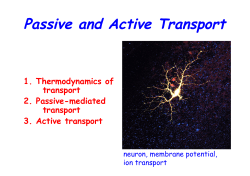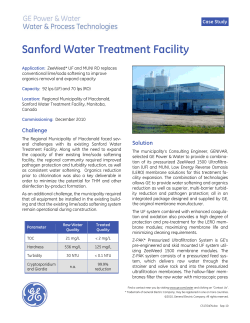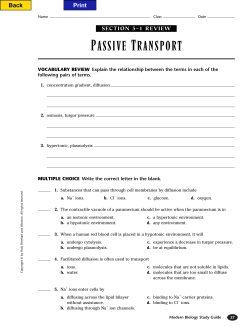
Brief Review of Filtration Methods
Brief Review of Filtration Methods Not all of the filtration methods included in this paper produce an end-product that can be labeled “honey.” Such products should be considered honey products and labeled accordingly. Please refer to the definitions document for honey products (http://www.honey.com/images/downloads/honeydefs.pdf ) for further information on product terminology. Introduction Separation systems are used in many industries to remove undesired compounds or to retain desired ones. Commonly used systems are membrane separation systems, ion exchange, adsorption, distillation and evaporation. In the food industry, these systems are used for many purposes including purification of water, concentration and clarification of beverages and management of wastes.1 This paper will focus on the membrane separation systems, ion exchange and adsorption because of their interest to the honey industry. Distillation, evaporation and ion exchange are less commonly used because they are expensive and inefficient, requiring high amounts of chemicals and energy.2 However, more than one separation method can be used in sequence for efficiency.3 Membrane Systems In membrane separation systems, liquid containing two or more components comes into contact with a membrane that permits some components (for example, water in the fluid) to pass through the membrane (the permeate), while other components cannot pass through it (the retentate). The physical and chemical nature of the membrane (for example, pore size and pore distribution) affects the separation of the liquid and its components.1 Hydrostatic force is the key driving force in achieving separation.1 The smaller the pore size, the smaller the size of the particles that can pass through the membrane. 2 As the pores get smaller, the system is more costly to operate. Larger pores have fewer membrane elements and lower operating pressure. 2 Relative pore size of the membranes used in separation systems in decreasing size are: microfiltration, ultrafiltration, nanofiltration and reverse osmosis. Pore size is measured in (decreasing size) micrometers (µm), Angstroms (Ǻ) (10 billionth of a meter) 2 and/or molecular weight (MW). Membranes rated are in terms of pore size or porosity.4 1 Diatomaceous Earth Although not technically a membrane system, natural diatomaceous earth (DE) functions similarly to membrane filters. DE is the remains of microscopic one-celled plants (phytoplankton) called diatoms that lived in the oceans. Large deposits were left behind when the oceans receded. Diatomaceous earth is mined and has several important uses as a filtering material for foods and beverages. DE is approximately 3% magnesium, 86% silicon, 5% sodium, 2% iron and has many other trace minerals such as titanium, boron, manganese, copper and zirconium. Pore size ranges from 0.5 - 22 micrometers (µm) • The particles being screened are smaller than the naked eye. • Examples of the particle size removed are: wax, pollen, bee parts, wood chips, and some bacteria. • Typical equipment used: filters and filter presses. Diatomaceous Earth cont. DE is often used to filter honey as it functions to reduce non-honey particulate matter. Most pollen, wax and some bacteria can be removed through the use of DE. This helps remove the presence of any particulate and produces a very clear end-product. In order to use DE, honey needs to be heated slightly to allow it to pass through the micropores. The use of DE for filtering honey is regulated in the EU depending upon the level of filtration. According to the EU, if DE is used to thoroughly remove the pollen from honey, it may be difficult to identify the botanical and geographical origin. This level of filtration also makes it difficult to identify other microscopic elements normally found in honey. Use of membrane systems to separate substances of different sized molecules.[From Cheryan, M. (1989). Membrane separations: mechanisms and models. In “Food Properties and Computer-Aided Engineering of Food Processing Systems” (R.P. Singh and A. Medina, eds.). Kluwer Academic Publishers, Amsterdam]. See “The Filtration Spectrumi” from Osmonics (pg. 8) for a pictorial explanation of units of measure, relative sizes of materials and separation processes for these materials. Macrofiltration or Particle filtration Pore size: 10 to 1000 micrometers (µm) • The particles being screened are visible to the naked eye. • Examples of the particle size are: bubbles, insect parts, dust, debris, crystals. • Typical equipment used: bag filters, cheesecloth, metallic screens, nylon mesh. • This method produces a more “natural” style product. 2 Microfiltration Pore size: approximately 0.1 to 10 micrometers (µm) • The particles being screened are not visible to the naked eye.2 • Examples of the particle size are: yeast cells, red blood cells, coal dust, and some bacteria.2 • This pore size is used for sterile filtration, cell harvesting or clarification of fruit juices and in applications where water taste is not as important, like breweries.3 However, it is the least used because of the availability of finer membrane systems. • It retains particles from about 200 to 1000 Å.4 • Two types of microfiltration systems: cross flow and dead-end.5 • The least amount of hydrostatic force required.1 Ultrafiltration Pore size: to 0.001 to 0.1 micrometers (µm) or 1,000 to 100,000 molecular weight (MW) • Ultrafiltration is a process of separating colloidal or molecular particles by filtration, using suction or pressure, by means of a colloidal filter or semipermeable membrane.7 • This method is only somewhat dependant upon charge of the particle and is more concerned with the size of the particle.8 • UF membranes are useful in separating components by rejecting macromolecules.1 and allowing passage of all salts through the membrane.2 UF is used to separate milk proteins by passing milk at high pressure through a very fine membrane,7 as a pretreatment for other purification systems (like ion exchange) where organics are not removed, gelatin and protein concentration in pharmaceutical industry, sugar clarification, cheese whey concentration, oily waste concentration in heavy industrial applications and electronic deposition for paint applications.2 It can be fine-tuned to selectively remove proteins or sugars, concentrate skim milk for ice cream.3 • Ultrafiltration retains particle larger than 15-200 Ǻ.4 • Higher pressures required.1 3 Nanofiltration Pore size: Particles in the molecular range from 0.0001 µm to 0.001 µm or 250 to 400 MW • Nanofiltration is the newest of the major methods, serving as an intermediate between ultrafiltration and reverse osmosis.3 • This process allows some salts through the membrane,2 allowing monovalent ions to pass while rejecting high percentages of divalent cations and multivalent ions.4 • Nanofiltration membranes are rated in terms of percent salt rejection and flow.4 • This process is used for sugar concentration, dye desalting, water softening, color removal in water,2 removing bacteria, some proteins6 by dairy industry, and meat processors for recovering value added by-products and making water suitable for discharge.3 • Separation by this method is affected by the charge of the particles being rejected – particles with larger charges more likely to be rejected than others.6 • This method is not effective on smaller weight organics like methanol.6 Reverse osmosis (RO) or Hyperfiltration9 Pore size: Particles in the ionic range from about 0.001 micrometers (µm) and below or less than 125 MW • RO has the finest membrane size.3 • In reverse osmosis, the natural process of osmosis is countered by applied external pressure. Normally, pure water would move from a region of higher concentration (such as pure fresh water) into one of lower concentration (such as a solution of water and salt). RO causes the water to move out of the salt solution, opposite of what would naturally occur.7 • The most common force is pressure generated by a pump. The higher the pressure the higher the driving force.9 Considerably higher pressures are necessary to overcome osmotic pressures.1 • RO allows only pure water through the membrane, filtering out inorganic salts, some forms of non-ionic organic compounds such as fructose (MW 180) and smaller organics such as ethyl alcohol (MW 46).2 • RO is used to reduce inorganic salts in water that has demanding specs such as boiler feed water, car wash rinse water, potable water, glass rinsing, pure water for dialyses, beverages, pharmaceutical water and maple syrup concentration.2 It can also be used to remove bacteria, salts sugars, proteins, particles, dyes9, water recycling, concentrating milk solids and removing water from whey.3 • With RO, the charge of the particles (ions) facilitates separation. The larger the charge and the larger the particle, the more likely it will be rejected.9 4 • RO membranes are rated in terms of percent salt rejection and flow.4 • Several different membrane structures are used in these processes. For UF and RO systems they are spiral wound, hollow fiber, plate and frame and tubular elements.1 • Pleated cartridges are used for microfiltration and UF systems.11 Materials used to make membranes are cellulose acetate, polymers, such as polyamides and polysulfones and composites (or ceramic) of porous carbon, zirconium oxide or alumina.12 Ion exchange This process is not a membrane separation system. Rather, it is a chemical reaction by which ions are interchanged between one substance and another, usually by means of passing a liquid through a porous, granular solid (such as activated carbon) that is relatively insoluble.7 The process replaces selected anions or cations in a solution. Ion exchange is also called “preferential adsorption.” Distillation and deionization are other means of removing impurities at the ionic level. Deionization or ion exchange systems consist of a tank containing small beads of synthetic resin. The beads are treated to selectively adsorb either cations or anions and exchange them based on their relative activity compared to the resin. This process of ion exchange will continue until all available exchange sites are filled, at which point the resin is exhausted and must be regenerated.2 This process is used to remove unwanted substances in water softening, to remove undesired colors in juices or to recapture desirable materials like valuable metals in wastes7. It also can be used to remove certain salts of calcium and magnesium from sugar juice prior to refining and to remove certain ions for clarification of wine. Ion exchange is often used directly after a solid adsorption process to remove undesired colors in sugar juices.12 5 Glossary Activated carbon – A highly porous form of charcoal treated so it can readily adsorb large quantities of gases, vapors or undesirable impurities, widely used in filtering systems. 7 Adsorption – to take up or hold on the surface10 (This is distinguished from absorption, a process where one substance actually penetrates into the inner structure of the other. 7) Anion – an ion with a negative (-) charge Cation – an ion with a positive (+) charge Colloid – fine particles suspended in a liquid or solid10 Diatomaceous Earth (DE) - the remains of microscopic one-celled plants (phytoplankton) called diatoms that is used to filter liquids. Divalent ion – an ion with two charges (either positive or negative) Hydrostatic force or pressure – the pressure due only to the weight of the fluid in the column above the point at which it is measured7 Ion – an atom or molecule with a positive or negative charge10 Membrane – a barrier between two fluids that allows transport between the fluids by absorption or adsorption and diffusion7 Monovalent ion – an ion with one charge (either positive or negative) Multivalent ion – an ion with a charge, either positive or negative greater than two Permeate – that which passes through a membrane1 Retentate – that which doesn’t pass through the membrane and is concentrated or collected1 Semi-permeable membrane – a membrane that allows the passage of only certain molecules7 6 References 1 Singh, R.P. and Heldman, D.R. 1993. “Introduction to Food Engineering,” 2nd ed. Academic Press, Inc., Harcourt Brace & Company, San Diego, California. 2 http://www.gewater.com/library/tp/710_The_Filtration.jsp 3 Neff, J. 1999. The finer points of filtration. Food Processing 60(3): 96-100. 4 http://www.gewater.com/library/tp/950_Explore_the.jsp 5 http://www.gewater.com/library/tp/836_Microfiltration_.jsp 6 http://www.gewater.com/library/tp/834_Nanofiltration_.jsp 7 Morris, C. ed., 1992. “Dictionary of Science and Technology,” Academic Press, Inc., Harcourt Brace & Company San Diego, California. 8 http://www.gewater.com/library/tp/835_Ultrafiltration_.jsp 9 http://www.gewater.com/library/tp/833_What_Is.jsp 10 Gould, W.A. 1990. “Glossary for the Food Industries.” CTI Publications, Inc. Baltimore, Maryland. 11 Dziezak, J.D. 1990. Membrane separation technology offers processors unlimited potential. Food Technol. 44(9): 108-113. 12 Heldman, D.R. and Hartel, R.W. 1997. “Principles of Food Processing.” Chapman & Hall, New York, New York. 13 Krell. R. 1996. “VALUE-ADDED PRODUCTS FROM BEEKEEPING.” FAO Agricultural Services Bulletin No. 124. Rome, Italy. Prepared by the National Honey Board, 2004 7 The Filtration Spectrum Micrometers (log scale) Angstrom Units (log scale) Approx. Molecular Wt. (Saccharide Type-No Scale) 1 SCANNING ELECTRON MICROSCOPE ST MICROSCOPE Ionic Range Molecular Range Macro Molecular Range 0.001 0.01 0.1 1 10 100 200 100 1000 10,000 104 1000 20,000 100,000 OPTICAL MICROSCOPE Micro Particle Range 1.0 10 105 106 107 500,000 Albumin protein Relative VISIBLE TO THE NAKED EYE Macro Particle Range 100 1000 Yeast cells Pin Aqueous salts Pollen Size of Viruses Atomic Radius Sugar Tobacco smoke Common Materials Pesticides Reverse Osmosis Gelatin 1 Ultrafiltration Particle Filtration Microfiltration 1 Micron (1x10-4 meters) = 4x10-6 inches (0.000004 inches) 1 Angstrom Unit = 10-10 meters = 10-4 micrometers (Microns) Adapted from Osmonics, Inc. The Filtration Spectrum. 1996. Minnetonka, Minn. Human hair Giardia (Hyperfiltration) Nanofiltration Note: Milled flour Asbestos Herbicides Process Used for Separation Beach sand Bacteria
© Copyright 2025





















